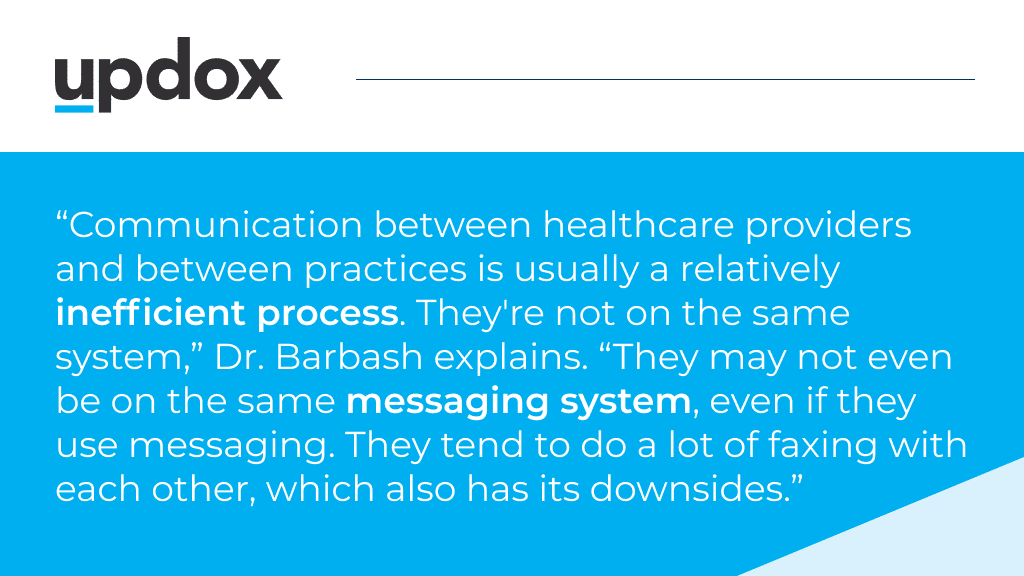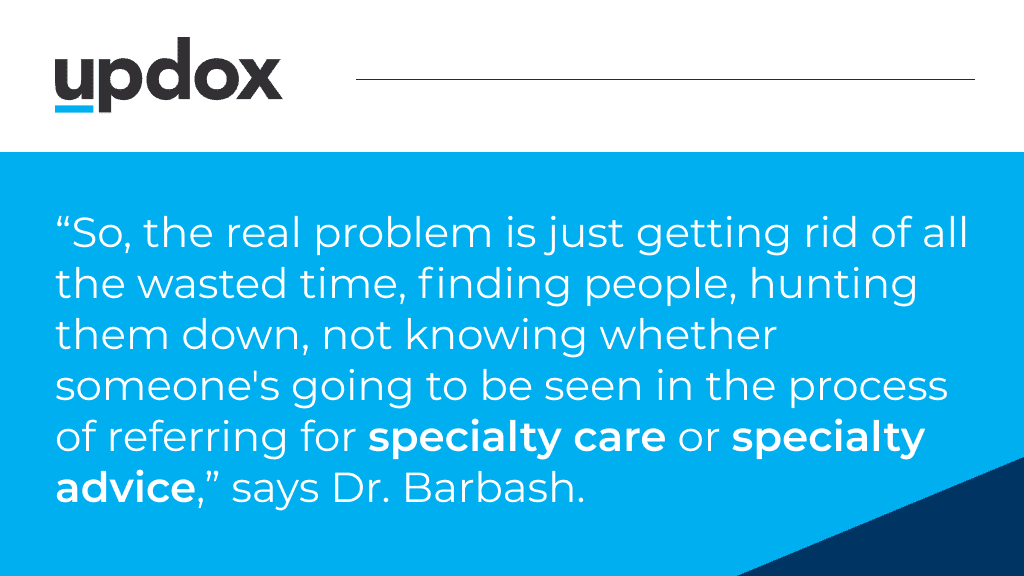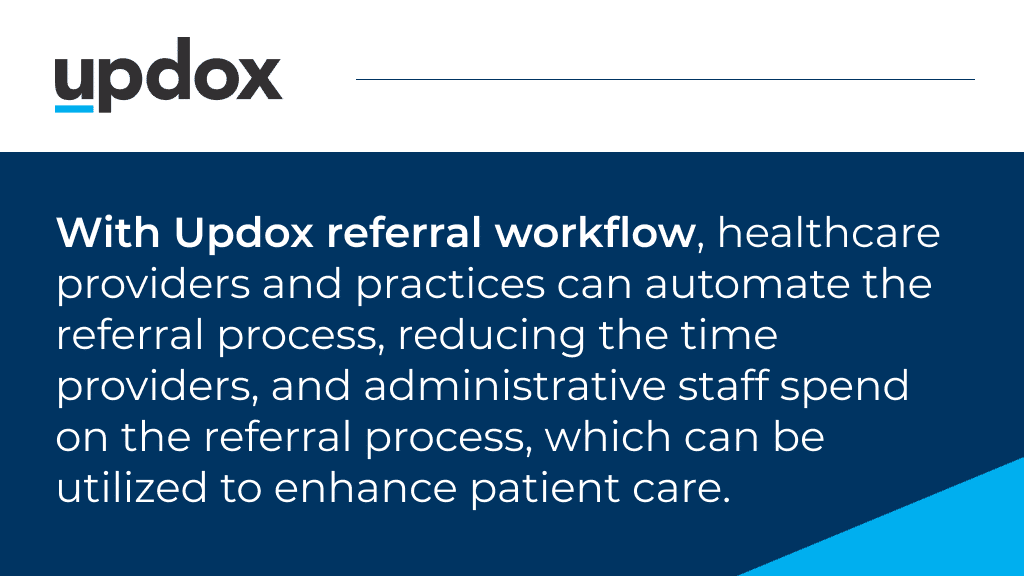Inefficient communication between healthcare providers and practices is a widespread problem that can negatively affect the quality of care. “The process of communication, as we all know, has always been a real bugaboo in healthcare,” says Dr. Barbash, retired neurologist and founder of Updox, an all-in-one suite of Practice Productivity and Patient Engagement solutions.
“Communication between healthcare providers and between practices is usually a relatively inefficient process. They’re not on the same system,” Dr. Barbash explains. “They may not even be on the same messaging system, even if they use messaging. They tend to do a lot of faxing with each other, which also has its downsides.”
This is particularly true when it comes to referrals. Healthcare providers often struggle with finding the right physician for a referral, coordinating communication, and ensuring timely availability. In fact, the referral process is often handed off to administrative staff, who may lack medical judgment or experience.
Updox, a leading healthcare collaboration platform, offers a solution to this problem referral workflow. In this blog post, we sit down with Dr. Barbash as he walks us through the Updox referral workflow solution and how it can improve a traditionally inefficient process.

What is a referral workflow and what problems does it solve?
“A referral is really a communication between one practice and another,” explains Dr. Barbash. “So that could be a primary care practice needing to get specialty care on behalf of a patient, it could actually be just kind of a consultation directly between providers to just review some records and discuss a particular case.”
A referral workflow is a set of processes that healthcare providers follow when referring patients to specialists or other healthcare providers for additional care. The process involves several steps, including choosing an appropriate specialist, coordinating schedules, and exchanging patient information.
The referral workflow can be an administrative nightmare due to inefficiencies such as long wait times, lost paperwork, coordination mishaps, and gaps in communication. These inefficiencies can lead to missed appointments, delays in treatment, and frustration among patients and healthcare providers.
“So, the real problem is just getting rid of all the wasted time, finding people, hunting them down, not knowing whether someone’s going to be seen in the process of referring for specialty care or specialty advice,” says Dr. Barbash.
Using this workflow, providers can quickly and securely exchange information, track the referral process, communicate with other providers, and receive feedback without delay. This workflow reduces the time spent on non-clinical tasks, such as phone calls, faxes, and follow-ups, allowing providers to focus on patient care, which ultimately improves patient satisfaction and outcomes.

How does the Updox referral workflow solution work and how does it help improve the referral process?
Updox referral workflow allows healthcare providers to manage the entire referral process from start to finish, all within the Updox application. When a referral is made, Updox automatically notifies the appropriate provider, who can then confirm or decline the referral. Once a referral has been accepted, Updox facilitates communication between the referring and referred providers.
Additionally, the Updox referral workflow makes scheduling appointments, notifying patients, and sending electronic medical records easy. With the Updox referral workflow, practices can reduce errors, streamline communication between providers, and ensure that patients receive timely and effective care.
Examples of Various Referral Workflows
One example is when a primary care practice may sometimes need to refer a patient to a specialist in GI or cardiology for various reasons, such as a yearly check-up, patient request, or evaluation of symptoms.
To simplify and streamline the referral process, a custom form can be used to collect information and create a request that is directly transmitted to the intended practice. With online confirmation and clear communication, it becomes easy to track and receive the report as desired.
Another example is when a patient returns to a specialist’s office for follow-up care, it’s because the specialist is currently more involved in their medical care, typically because the patient has a specific condition that requires specialized attention.
This is often the case even when the patient also has a primary care provider. Similarly, in the case of women’s care, such as with an OB/GYN, they may receive the majority of their medical care from this specialist, even while having a primary care physician.
A third workflow example is when a patient wants to enroll in a clinical trial for their unusual condition and there’s a local practice participating in the trial. The practice might have created a custom form and even a work queue that other connected practices can access.
Once the referring physician or specialist accesses the form, the practice will receive the message and any necessary additional information. The referring physician or staff can easily access the needed information and send it over in a message. The practice can then quickly evaluate if the patient qualifies for the clinical trial. Overall, it is a messaging communication process that simplifies the referral process.
Why would a practice need to use the Updox referral workflow?
The referral process is critical to providing quality patient care. However, this process can be inefficient and time-consuming if done manually. “And a lot of times you’re reverting to handing it off to staff and getting the providers out of the process, which is not necessarily ideal,” Dr. Barbash points out.
“Or they’re just making referrals and really not having much of an idea of when a patient is actually going to be seen, who they’re going to be seen by. And so it becomes kind of a black box,” Dr. Barbash continues.
“Then the patient gets stuck in the middle of a process where they have to figure out where they’re being referred to, is their insurance going to be accepted? Is there information that’s actually needed? Are there forms that are going to have to be filled out when they show up at the specialist office? So the patients have their own set of tasks, the referring provider has their own set of tasks. The people that are receiving the specialties may or may not have their own set of tasks.”
The Updox referral workflow comes with numerous benefits for practices by allowing practices to connect with specialists using the same platform, minimizing the need for phone and fax communications. Practices can coordinate scheduling directly on the platform, reducing errors and increasing efficiency.
With Updox referral workflow, healthcare providers and practices can automate the referral process, reducing the time providers, and administrative staff spend on the referral process, which can be utilized to enhance patient care.
This process is transparent and fully auditable for all parties involved. Every aspect of the referral – from the event to the transmission, comments, and messages – is visible and trackable. Those who initiate the referral, those who respond to it, and those who facilitate the transaction can easily monitor all audit activity.
The referral workflow allows providers to manage referrals easily, create referral documentation, and communicate securely with other healthcare providers to coordinate care for their patients.

Who would best benefit from this workflow solution?
Updox referral workflow is designed to help physicians, specialists, and other healthcare providers streamline their referral process. The workflow solution is perfect for practices of all sizes, particularly those with multiple providers and administrative staff involved in the referral process.
Compared to traditional referral processes, the Updox referral workflow saves time, reduces errors, and increases patient satisfaction by providing a smooth and efficient experience.
Improve Your Referral Process with Updox
If your practice is currently using a manual referral process, you know that it can be time-consuming, prone to errors, and result in less successful referrals.
With Updox, you can make and receive referrals, request and schedule appointments, and quickly send patient records all within one digital platform.
Updox Communication Platform will help improve your patients’ experience, enhance your practice’s productivity, and organizational profitability all while seamlessly integrating with most EMRs.
If you’re a healthcare provider or practice seeking to improve your practice and patient satisfaction, contact us for a demo of Updox today!




